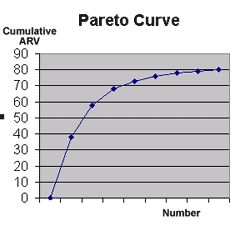ABC Analysis/Pareto Analysis
Pareto analysis (sometimes referred to as the 80/20 rule and as ABC analysis) is a method of classifying items, events, or activities according to their relative importance. It is frequently used in inventory management where it is used to classify stock items into groups based on the total annual expenditure for, or total stockholding cost of, each item. Organisations can concentrate more detailed attention on the high value/important items. Pareto analysis is used to arrive at this prioritisation.
Taking inventory as an example, the first step in the analysis is to identify those criteria which make a significant level of control important for any item. Two possible factors are the usage rate for an item and its unit value.
Close control is more important for fast moving items with a high unit value. Conversely, for slow moving, low unit value items the cost of the stock control system may exceed the benefits to be gained and simple methods of control should be substituted.
These two factors can be multiplied to give the annual requirement value (ARV) – the total value of the annual usage.
If the stock items are then listed in descending order of ARV, the most important items will appear at the top of the list. If the cumulative ARV is then plotted against number of items then a graph known as a Pareto curve is obtained.
 The precise shape of a Pareto curve will differ for any analysis but the broad shape remains similar – following ‘the 80/20 rule’. Vilfredo Pareto was a 19th century economist who observed that 80% of Italy’s wealth was owned by 20% of the population.
The precise shape of a Pareto curve will differ for any analysis but the broad shape remains similar – following ‘the 80/20 rule’. Vilfredo Pareto was a 19th century economist who observed that 80% of Italy’s wealth was owned by 20% of the population.
In this case, typically, the first 20% of items in the list will account for approximately 80% of cumulative ARV. For a company with a stock list of 1,000 different items this means that paying more attention to the top 200 items (with a sophisticated stock control system) will give close control of about 80% of total stock investment.
The next, say, 40% of items, will, typically, account for a further 15% of cumulative ARV. These can be subject to less precise control methods.
The last 40% of (low value of low usage) items then account for a mere 5% of ARV and can be controlled with a simple system.
The alternative term ABC analysis stems from the fact that the first 20% of important items are known as Category A items, the next, typically 40% are Category B items and the relatively unimportant, though larger in number, 40% are Category C items.
Other examples
Control of travel costs: again, typically, 20% of journeys will account for 80% of total travel costs – and should be closely monitored and controlled.
Quality control: failure modes can be prioritised depending on their impact on a system’s performance.
